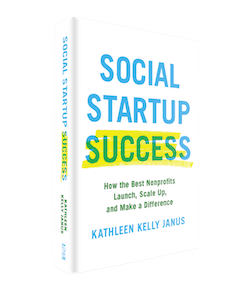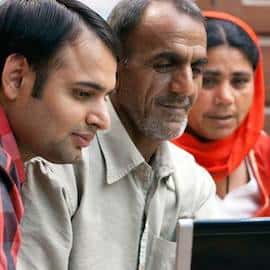Key Strategies for ‘Social Startup Success’: A Q&A with Spark Co-founder Kathleen Kelly Janus
For the past five years, Stanford lecturer and Spark co-founder Kathleen Kelly Janus has traveled the country speaking with the founders, leadership teams and funders of dozens of nonprofits and social businesses, both new and established, including One Acre Fund, Teach for America, City Year and charity:water. The result of these conversations is Social Startup Success: How the Best Nonprofits Launch, Scale Up and Make a Difference, which Janus calls “a guidebook for how to achieve breakthrough impact in the nonprofit sector.” The book highlights best practices for addressing several priorities that are relevant to both nonprofit and for-profit enterprises, and it’s already garnering a warm reception in the social sector, with Muhammad Yunus calling it an “important catalyst for training the next generation of social entrepreneurs on how to change the world.” NextBillion Associate Editor Sonya Vann DeLoach discusses the book’s message with the author in this email interview.
Sonya Vann DeLoach: Why do you say the struggle to scale is the most pressing challenge for the social entrepreneurship community, and what can investors, donors or others do to help social entrepreneurs navigate this challenge?
Kathleen Kelly Janus: A few years ago, after starting a small nonprofit in San Francisco, Spark, we hit the funding wall. Although we were having impact, we couldn’t get the capital we needed to grow. I started researching the question and I found that the funding wall is real: In fact, two-thirds of nonprofits in the U.S. are $500K and below in revenue. I became really curious: Who are these organizations all around us that were breaking through that wall and why were they more successful? Over the past five years, I have surveyed hundreds of top-performing organizations, traveling the world to meet with 100 social entrepreneurs, their staff, funders and board members trying to figure out the secret to scale. “Social Startup Success” outlines the five strategies that set these organizations apart – testing ideas, measuring impact, funding experimentation, leading collectively and storytelling purposefully. I’m excited to share these findings with the world so that other nonprofits can learn from the best breed of organizations to launch their own social startup success, and so that funders can support them through capacity building to navigate these challenges.
SV: Why is it so important for a startup “to work hard to identify and interview the full cast of characters who will play a role in the success of your organization”? Give examples of what can happen when a business does this well – or neglects to do it sufficiently.
KKJ: Working with beneficiaries is critical because you have to develop a feedback loop to make sure that your programs are as impactful as they can possibly be. For example, when Nadine Burke Harris founded the Center for Youth Wellness to address toxic stress due to adverse childhood experiences (ACE’s), she had a goal of creating a survey that could be used in every pediatrician’s office in the country to diagnose ACE’s. But doctors were impatient and wanted it immediately, so she engaged them in the development process, giving them a test survey and asking them for feedback on how it was working. This allowed her not only to develop a better survey, it also helped her to get buy-in from her constituents, which has been critical to movement building.
SV: How can a social entrepreneur create a compelling theory of change, and why is this essential?
KKJ: A theory of change is an explanation of precisely how an organization is going to achieve its vision. A good theory of change connects an organization’s vision with its day-to-day programs. Any organization, no matter how big or small, can create a theory of change by starting with a single question – “what does success look like for us.” Then work backward to outline the benchmarks that have to happen in order to get there. It sounds simple, but it’s a process that many organizations don’t do well. In Social Startup Success, I give several examples of how organizations can develop a good theory of change, demystifying the process and breaking it down into something really quite simple.
SV: Why should founders bring senior managers aboard early, and what can happen if they don’t?
KKJ: Senior leadership is critical to the path to scale. In my survey of over 250 social entrepreneurs, one of the strongest findings was that the organizations that tended to scale more quickly said that a catalyst for growth was hiring a chief operating officer, or a director of programs, or a head of development. And that makes sense because they say that hiring their senior team was what allowed them to focus their time on the strategic planning and fundraising that helped their organization grow. Senior leadership is also critical for a second reason: succession planning. You need to be hiring senior leaders who can step into the role of executive director if for some reason the founder cannot serve, so that the organization can live beyond the original founder.
SV: Why is failure, and knowing when to admit failure, so critical to the innovation process?
KKJ: The “freedom to fail” is vital to nonprofits because it’s a natural part of the learning process. Thomas Watson, the founder of IBM, famously once said, “If you want to succeed, double your failure rate.” So this is something that the business world has long known, but the nonprofit world has been slow to adopt because the incentive structures are not set up for it. If you’re a nonprofit, it seems like you would want to tout your successes and hide failures so that you can continue to raise money for your organization. But I actually found in my interviews of over 100 top social entrepreneurs that in fact, the opposite is true: that the most successful organizations not only talk about failure openly, they reframe their failures as learnings, which helps them improve their programs and ultimately make them better. That’s social startup success!
SV: Talk about the ways breakthrough social entrepreneurs use human-centered design to develop their products or services – why is this so important in the social sector?
KKJ: Human-centered design principals are perfectly suited for the early stages of a nonprofit because they allow organizations to rapidly test ideas, improving on what’s not working and embracing what is working. For those who don’t have experience with human-centered design, it might seem intimidating, but really it can be broken down into four simple steps. 1. Research the problem by talking with people who are directly affected by the problem; 2. Brainstorm solutions to the problem, ideally with the communities themselves; 3. Prototype the best ideas by creating ways to test them in a small and inexpensive way; and 4. Pilot the program with communities. The process is iterative, so you should be constantly working through this testing process, and improving on your solution all the way through the scaling process and beyond.
SV: Describe how powerful storytelling can boost a social startup’s fundraising and growth – and even help it make optimal use of data.
KKJ: You can’t start a movement without telling a good story. What people don’t realize is that practice is crucial to doing storytelling well. I think we all have the tendency to watch a TED talk or a good political stump speech and think, “Wow, that’s really good; they’re such a natural.” But in my interviews of over 100 social entrepreneurs, I’ve learned that the best storytelling comes with a lot of practice. The founder of The Center For Youth Wellness, Nadine Burke Harris, talks about how public speaking is her exercise. She studies famous speakers, like the Rev. Dr. Martin Luther King Jr., to see what makes them effective and tries to emulate them in her own speaking. Before she gives any talk, she says it out loud several times to memorize it so she’s speaking without notes to give her speech more power and allow her to connect with her audience. This can seem super daunting because it is a lot of work, but I think it’s also really freeing to know that anyone can be a good public speaker with practice, because speeches are how social movements are made – so we should all care about public speaking if we want to make a difference in the world.
SV: What is your advice to entrepreneurs seeking to attract impact investment without sacrificing their social missions?
KKJ: You have to constantly reaffirm your mission to ensure that you stay on track. Test whether you are staying true to your vision by calling up your staff or board and asking them to articulate your mission statement in a sentence. If they can’t do that, you may need to go back to the drawing board to ensure that everyone is on the same page.
Sonya Vann DeLoach is associate editor of NextBillion.
Photo courtesy of Kathleen Kelly Janus
- Categories
- Social Enterprise
- Tags
- nonprofits




